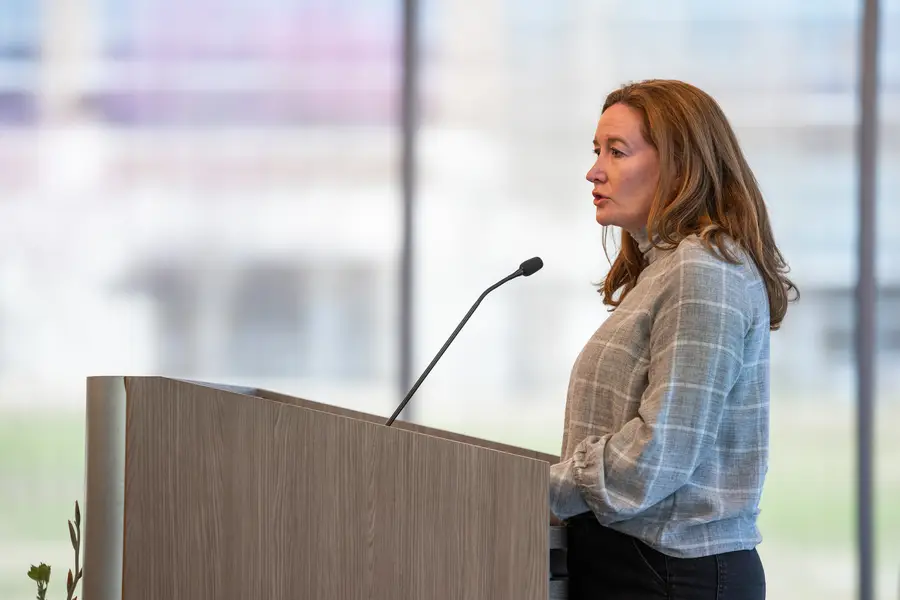Duren Banks speaking at the 2023 RTI Symposium on Community Safety and Policing Research.
Addressing the Complex Nature of Firearm Violence in the U.S.
Firearms are the leading cause of death in people 19 and younger and is among the five leading causes of death for people aged 1 to 44 in the United States. Firearm violence is an urgent public health and public safety problem that affects communities, schools, and residents throughout the United States. Reducing firearm violence is a multifaceted task, requiring public health, public safety, legal, and community interventions.
To address the complex nature of firearm violence in the U.S., RTI developed the Center for Evidence-Based Strategies to Reduce Firearm Violence. We sat down with researchers Duren Banks and Josie Caves Sivaraman to talk about RTI’s new Center and the ways it plans to address firearm violence across the country.
Tell us more about the Center for Evidence-Based Strategies to Reduce Firearm Violence
RTI researchers have conducted a number of projects to examine the correlates of firearm violence and explore various strategies to address it, focusing in particular on suicide, school safety, firearm investigations, and violence prevention. However, our work has been largely dispersed across multiple components of RTI and we saw an opportunity for a greater impact with intentional coordination, partnering, and portfolio development.
The approach for RTI to unify this work under the umbrella of a dedicated Center and also connect directly with North Carolina was proposed to our CEO, Tim Gabel. Tim was particularly concerned about the growing number of mass shootings that we are witnessing as a nation, as well as the significant impact that firearm violence is having on young people, including the rising number of suicides. He and the Center team believe that RTI is poised to make important contributions to addressing this problem starting in North Carolina.
Since the Center’s inception, a cross-Institute Steering Committee has focused on collating existing research taking place at RTI to identify areas of strength and places for growth. We are in the process of awarding internal funds to help RTI researchers develop public-facing products from existing work, and/or to create papers or publications identifying gaps and solutions. We’re also working on deepening our relationships with North Carolina public health and safety officials, as well as policymakers. We’re very excited and inspired by the level of interest that the Center has generated across the Institute.
What are the biggest challenges to reduce firearm violence?
A big challenge to reducing gun violence—and part of why Tim felt that RTI would be able to make a difference—is that for about two decades there was almost no investment in gun violence research at the federal level. This really stagnated our ability to test, titrate, and prioritize interventions and policies, and to create the basic data infrastructure that would support such work. All of that is beginning to change, though the level of investment still does not weigh up to the toll that gun violence takes on our communities. Another, related problem is that although this is a public health problem, it has largely been dealt with using public safety and criminal legal system approaches. Another strength that RTI can offer is that we have relationships and experience working with data structures across those systems, so we can facilitate conversation and collaboration.
What is the center doing to reduce firearm violence?
So much! A lot of our ongoing projects are featured on the website. Broadly, we’ve categorized those into community violence prevention, school violence prevention, data systems and tools, and NC-based projects. Of course, there is overlap between these categories. One project that a number of us were recently involved in was a national evaluation of school safety tip lines, where we were able to demonstrate how tipline implementation is associated with reduced school violence, and we were able to describe the importance of properly training students on usage. Another, quite different project is the National Case Closed Project, in which RTI is helping law enforcement agencies improve case clearance rates, with an emphasis on fatal and nonfatal firearm crimes. This project is really important because it is improving our understanding of nonfatal shootings—a dimension of gun violence that has been overlooked for some time.
What is your hope for the future of the center?
We hope that the Center can serve as an internal and external resource to promote the work that RTI is doing related to firearms injury prevention. We are working to bring together researchers from different specialties to form new multi-disciplinary collaborations, which are desperately needed to address the gun violence epidemic. More than anything, we hope that the Center will make it possible for RTI to contribute meaningfully to reducing firearm violence in North Carolina and across the nation.



